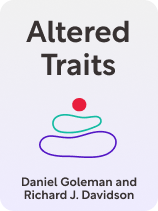

This article is an excerpt from the Shortform book guide to "Altered Traits" by Daniel Goleman and Richard J. Davidson. Shortform has the world's best summaries and analyses of books you should be reading.
Like this article? Sign up for a free trial here.
Is meditation just a passing fad, or can it truly change your brain? What benefits can you expect from a regular meditation practice?
Meditation has gained popularity in recent years, but its effects are often misunderstood. Altered Traits, a book by Daniel Goleman and Richard Davidson, explores the science behind meditation. The authors separate fact from fiction and reveal how different types of meditation can impact your mind and body.
Read on to discover the surprising ways meditation can transform your life, backed by rigorous scientific research.
Altered Traits Book Overview
Altered Traits, a book by Daniel Goleman and Richard Davidson, discusses the progress of the West’s scientific study of meditation. With a focus on identifying rigorous studies, the authors separate the signal from the noise to clarify what we do and don’t know about how meditation can change the mind—and, therefore, the meditator.
As they put it, meditative practices have long proven difficult to understand and explain. For instance, hucksters and modern businesses seeking to capitalize on the popularity of meditation often overhype its benefits. This difficulty in understanding meditation spills over into research, where it muddies the waters of understanding and casts doubt on the results of academic studies.
To address this dilemma, the authors define meditation and clarify why studying it is hard. They then detail the most clearly supported benefits of meditation and argue that the practice has one key effect: It alters traits. In other words, it produces lasting changes to your brain and therefore how you live.
Goleman (Focus, Emotional Intelligence) and Davidson (The Emotional Life of Your Brain) are both psychologists, writers, and lifelong meditators who helped pioneer research on meditation in the modern West. Our overview presents their ideas in three parts:
- First, we’ll cover what meditation is.
- Second, we’ll explain why rigorous research on meditation is both difficult to conduct and crucial to do properly.
- Third, we’ll discuss what the best studies (so far) say about meditation and how it can change you.
Meditation: Definitions, Origins, and Contemporary Manifestations
To start with, we’ll cover how the authors define meditation, explain its traditional origins, and discuss what meditation has become in the modern West.
Meditation Is a Field of Practice
To begin, the authors make one key clarification: Meditation isn’t a single thing, but rather a field of practice. That is, “meditation” is similar to “athletics,” in that it refers to a wide variety of techniques and approaches. Different forms of athletics train your body in different ways, just as different forms of meditation train your mind in distinct ways.
As the authors explain, this means that the specific kind of meditation you choose corresponds to the results you get. So, if you want to research or practice meditation, you need to get precise about what kind you’re interested in. Pick a specific kind with means and ends that appeal to you. That way, it’ll be much easier to stick with your research or practice because you’ll enjoy the effort and the payoffs.
For instance, you wouldn’t practice barre to get a bodybuilder’s physique. In the same way, you wouldn’t prioritize loving-kindness meditation (which centers on cultivating compassion) if you want to train your ability to concentrate at will.
The Buddhism That Came to the West
If meditation refers to a field of practice rather than a singular thing, then what specific methods came to the West?
To answer this question, the authors explain that their interest in meditation began when they traveled to India to explore the spiritual traditions of the far-flung subcontinent. Distilling their experiences, they say that the most prevalent form of meditation in the modern West—mindfulness—comes in large part from Theravada, the oldest of the three major Buddhist schools. Mindfulness is a practice that centers on developing a calm, nonjudgmental awareness.
Theravadan teaching draws largely on the Visuddhimagga, a fifth-century Pali text that describes the Theravadan understanding of the Buddha’s teachings. According to the authors, when Buddhist organizations revitalized and popularized the Theravadan tradition in Burma during the 20th century, they stripped down its elaborate theory and practice to present a simplified version of meditation to the public.
That meditation method, the authors say, became what we know today as mindfulness. When they and a number of other Westerners went to India in the 1970s, they were taught according to the Burmese Theravadan tradition. They brought that method back with them.
Traditional Paths to Enlightenment
So modern mindfulness reached the West through the Burmese Theravadan tradition that the authors studied in India. But, what is it in practice, and how does it fit into the tapestry of traditional Buddhist practices? Historically, modern mindfulness draws on insight meditation, which the Buddha innovated to improve an earlier focus-based meditation method. Let’s explore that focus meditation first.
Focus Meditation
According to the authors, early Indian meditation practice centered on jhana, a state of intense bliss that arises from focusing on a single object like a candle or your breath. By repeatedly drawing your attention back to that focal point, you develop a quiet, absorbed state of concentration that, over time, becomes undisturbed by ordinary mental chatter.
The Visudhimmagga describes eight stages of jhana, beginning with absorption in one-pointed focus. Ultimately, the practice of jhana culminates in a final state of complete absorption in focus and accompanying sensations of blissful tranquility.
Insight Meditation
The Buddha is said to have practiced focus meditation. However, he also realized that one-pointed focus needs the complement of insight.
With a strong basis in focus meditation, which trains you to access deep concentration at will, you can also remain mindful—or open, nonreactive, and nonjudgmental—to whatever arises in your mind. In other words, you first focus, and then you learn to relax into a state of calm, open awareness by quietly observing the cacophony of transient thoughts, feelings, and sensations that you experience.
This way of being aware is called sati, which we translate as mindfulness. In the modern West, practitioners often apply sati through vipassana, the simplified mindfulness meditation method devised by Burmese Theravadans and taught to the authors (and other Westerners) in the 1970s. Most often, you start a vipassana practice by developing mindful awareness of your breath. In time, you gradually expand that basic awareness to observe and become mindful of the rest of your subjective experience.
According to the authors, when the Buddha combined focus with insight, he innovated a new path to nirvana, or enlightenment: a state of complete spiritual liberation characterized by tranquility, clarity of mind, bliss, and unshakably mindful awareness. For the authors, the question remained: Is enlightenment real? Do lifelong meditators and yogis really experience these states of profound concentration, bliss, clarity, and liberation?
Mindfulness in the Modern West
In its transition to the modern age and the Western world, mindfulness meditation has been reinterpreted and reformulated for many fields and uses. The authors explain that today, Westerners approach meditation either through more traditional means or more secular means:
- Via traditional means, you practice meditation as a way of life. You follow a time-honored path toward enlightenment, learning from a lineage of established teachers. Monks who take Buddhist vows and live in monasteries exemplify this path.
- Via secular means, you take meditation more as a tool for worldly self-improvement outcomes, such as better mental and emotional health. For instance, an entrepreneur might practice mindfulness to focus and to regulate his stress.
Along these two paths, the authors describe five depths of meditative practice that gradually step out from the deep end of traditional practice and into the shallow but broad end of secular practice:
- The first depth is “pure” meditation, or meditative practice done in a traditional context such as a monastery. This is the deepest possible commitment to practice.
- The second depth is meditation pursued with a similar level of seriousness, yet practiced in a Western context for a Western audience.
- The third depth is meditation practiced seriously, but more for personal growth than spiritual liberation. Rather, the goal is practical gains—for instance, some people meditate to improve their cognition and therefore become more productive.
- The fourth depth is meditation taken less seriously, used more as a “life hack” than a regular practice. For example, many people use apps or guided meditation videos to get a dose of mindfulness in a more ad hoc way and for purposes like stress relief.
- The fifth depth is speculative—the authors suggest that meditation technologies may become more democratically accessible, such that anyone can freely get meditation guidance on their phone at any time.
According to the authors, practicing meditation through traditional means, with a deep level of commitment, gives the most profound results. This would correspond to the first and second depths above. In the authors’ view, these more authentic ways to meditate provide the most compelling benefits, such as lasting changes to your brain that increase your capacity for compassion, selflessness, and tranquility.
In contrast, secular means (the third, fourth, and fifth depths) offer accessible benefits to more people. After all, not everyone is able to commit to a monastic lifestyle in a traditional Buddhist setting. However, secular tools often overpromise their benefits. For example, an app won’t solve all your mental health challenges (as some marketing might imply)—but it might, as the authors say, provide some shallower positive gains.
How Meditation Became a Field of Study
Now that we’ve shared how the authors define meditation, we’ll explain why it’s been so challenging to study. As they say, meditation research is a young and rapidly growing field, and much of the difficulty in understanding meditation arises from confusion about what it is, how to distinguish the forms it takes, and how to properly measure its effects.
We’ll detail the broad basis for meditation research (neuroplasticity, or the brain’s innate ability to adapt to stimulation). We’ll also describe the common misunderstandings and mistakes made in meditation research. Last, we’ll explain why it’s crucial to remain vigilant against hype when evaluating research and claims about meditation.
Meditation Induces Neuroplasticity to Change the Brain
When the authors first pushed to study meditation, the conventional academic perspective was against them. Most serious research scientists thought that meditation was too subjective or woo-woo, and that the mind was a black box—impossible to study rigorously.
Despite this resistance, the authors hypothesized early on that meditation could produce the titular “altered traits”—lasting changes to people’s basic characteristics. Depending on how you meditate, these can include increased stress resilience, emotional intelligence, and cognitive capacities such as attention, focus, and more.
Early on, the techniques available to measure the effects of meditation weren’t effective enough. However, the discovery of neuroplasticity provided a broad, scientifically viable basis for their research.
Neuroplasticity is the brain’s ability to change in response to some activity or stimulus. For instance, research on rats found that their brain health worsened after they were merely placed closer to unhealthy rats. When it comes to meditation, the discovery of neuroplasticity made it reasonable to claim that meditation could alter the brain. And as it turns out, the authors explain, the mental training of meditation does physically modify the structure, size, and functioning of brain tissue. As a result, traits that relate to those brain changes can shift as well.
Mistakes and Misconceptions in Research
Despite this evidence of the positive effects of meditation, it remains difficult to study. Research on meditation varies in quality, and mistakes and misconceptions can stand in the way of rigorous work.
Mistaking the Peaks for the Path
According to the authors, many researchers mistake the highs that meditation produces—states of deeply absorbed awareness, for instance—for the whole thing. However, they say, these highs are just temporary states that are more akin to an exercise high than a lasting gain in meditative capability.
For another analogy, consider weightlifting. When you work out, you get a pump—a temporary increase in the size of your muscles. But these pumps aren’t your gains—the lasting increases in the size and function of your muscles. In meditation, the high states are the pumps and the gains are the altered traits. When research focuses on temporary peaks as outcomes, it misses the broader picture of meditation as a long-term process with long-term aims.
Researcher Bias
Another issue is researcher bias, wherein the person conducting the study may unconsciously design the experiment, interpret the findings, or otherwise skew outcomes in ways that support their hypothesis. Goleman admits that in doing his own research, he once skewed the results by expecting what he wanted to see and then interpreting the data to fit those hopes.
Misunderstanding “Mindfulness”
Another key mistake arises from the ambiguity surrounding the term “mindfulness.” Many studies take it as a catchall term for meditation. According to the authors, it was originally meant as a translation of sati (the path of insight that the Buddha taught). However, it’s often incorrectly conflated with vipassana, the practice by which many Western meditators practice sati.
Because of the range of studies that have used mindfulness as a general term, it now means a wide variety of things. Accordingly, the authors say that many studies mistakenly lump research subjects who come from different meditation backgrounds into one general category. Because of this, the research isn’t precise enough to draw useful conclusions from.
For instance, a study might lump together practitioners from Zen, traditional Theravada, Tibetan Dzogchen, and Western mindfulness methods, thinking they’re essentially the same. But they aren’t—and because the study doesn’t distinguish between them, the authors would likely say that the results aren’t rigorous enough to support firm assertions.
Hyperbole and Exaggeration
Although the rapidly increasing interest in meditation is a positive development, the authors explain that more than ever, we must remain vigilant against hype.
Fields with spiritual roots, such as this one, are prone to frauds and hucksters, and today, businesses and advertisers are keen to cash in on the excitement. Many will overpromise the benefits of their products to sell apps, courses, and other tools. For these reasons, the authors stress the need to remain skeptical and rigorous in evaluating the data and determining what’s actually true about meditation.
According to the authors, the most widely touted benefits of meditation aren’t all they’re cracked up to be—and the benefits that are most supported by research remain undersung.
Meditation: What We Know and What We Don’t
Up to this point, we’ve discussed what meditation is and why it’s essential to carefully assess research and stay vigilant to hyperbole. Next, we’ll look at what the best studies do say about the effects that meditation has on the mind and the meditator.
Effect 1: Meditation Can Train Your Attention
Broadly put, meditation trains your attention, and this can improve related cognitive functions as you age. Different practices can boost various aspects of attention, and lasting benefits come with sustained practice, much as lasting muscular changes require continual training. According to the authors, both traditional and secular ways of meditating have been found to influence different aspects of attention:
- Mindfulness-Based Stress Reduction (MBSR) training, a popular modern method that Jon Kabat-Zinn created, can temporarily strengthen selective attention (your ability to choose what you focus on). MBSR is a secular eight-week program that aims to reduce stress, anxiety, pain, and other ills.
- Insight meditation (vipassana) may produce a trait change related to selective attention. Research suggests that consistent, long-term practice can make it more effortless to find and rest in a state of focused awareness.
- Mindfulness can reduce the damage that multitasking does to sustained attention. Research shows that whereas multitasking harms your ability to focus, as little as eight minutes of basic, secular mindfulness practice can restrengthen attention.
Effect 2: Meditation Can Help You Cultivate Compassion
Next, the authors explain that meditation can train you to feel positive emotions more deeply. These results come largely from research on loving-kindness meditation, or metta—a practice of extending compassion to yourself, those close to you, and all living beings.
According to the authors, prosocial emotions (positive feelings for other people) fall along a spectrum. On one end is simple empathy, or feeling for someone who’s suffering. In the middle is compassion, or feeling with them, and on the other end is altruism, or feeling strongly enough to actually help another person. Research indicates that loving-kindness meditation (practiced using traditional or secular means) may:
- Increase the odds that the practitioner actively helps someone who appears to be suffering. That is, metta predisposes people to altruistic action.
- Enhance empathy by activating brain circuits that process prosocial emotions as well as those that prime the body to respond to the suffering of others.
- Induce swifter changes to the brain than attention-based meditations—eight hours of metta can expand brain circuitry related to compassion, and sixteen hours may weaken the meditator’s implicit biases (or unconscious prejudices).
Effect 3: Meditation Can Transform Your Sense of Self
Pivoting away from these tangible benefits, the authors turn to meditation’s relationship with your sense of self. Traditional meditative paths aim to release the practitioner’s conventional sense of self—the persistent feeling and belief that “I am this person”—so they can reach nirvana. Emerging neuroscience might explain this goal: Research has begun to discover how the brain constructs your sense of self and how meditation may loosen the circuits that produce it.
As the authors explain, your sense of self comes from the brain’s default mode network (DMN), or the baseline state of absent-minded thinking and rumination that you experience daily. The DMN comes online when you’ve nothing in particular to do. It manifests as a persistent narrative voice that centers on yourself, monologuing about your day, your experiences, your pains and stressors, as well as experiences past and those yet to come.
By way of that continually unfolding narrative voice, you come to personally identify with your thoughts, emotions, sensations, pains, and so on. They all become your experience and constitute you. As a result, you have a distinct sense of self; a feeling that I am this person.
According to the authors, research has begun to show that meditation can lessen the DMN activity that creates this sense of self. In doing so, meditation leads the practitioner to a subjective experience with less definite boundaries between self and other. Studies indicate that:
- Mindfulness and loving-kindness meditations can both reduce the activity of the DMN. Scans show that in early stages, meditation strengthens brain circuits that inhibit DMN activity. In later stages, meditation begins to unwire the connections within the DMN itself.
- Lessened DMN activity begins as a temporary experience of ease and selflessness. With long-term practice, it can become a lasting trait. That is, the meditator’s sense of self weakens and her awareness becomes more tranquil.
Effect 4: Meditation May Improve Emotional Health
According to the authors, meditation has had a largely positive impact on psychotherapy and psychiatry, two modern Western approaches to healing the mind. At the same time, there isn’t enough evidence yet to say that meditation is broadly effective at treating mental health challenges. But the research is ongoing, and many psychologists have begun to experiment with meditation as a treatment tool in practical settings. Much of this research centers on Mindfulness-Based Cognitive Therapy (MBCT), and studies indicate that:
- Basic MBCT training may be viable as a treatment for depression. Some studies found it to be similarly effective to medication, yet lacking negative chemical side effects.
- Mindfulness training may also reduce anxiety. Research has found that basic mindfulness practice helps patients let go of patterns of negative self-talk and thereby reduce their anxiety.
- Loving-kindness meditation may help people suffering from trauma, such as those with PTSD. Specifically, it may help them process their trauma and reduce symptoms such as panic attacks.
As a cautionary note, the authors say that a small number of long-term meditators who explore meditation as a psychotherapeutic tool experience intense bouts of psychological distress at a certain point along the path. These cases are rare, however, and the research largely supports the promise of meditation-based approaches to therapy.
Effect 5: Meditation May Benefit Physical Health
What about the effects meditation may have on your physical health? According to the authors, the research shows promise yet remains tentative. Findings indicate that:
- MBSR may help palliative care patients experience less suffering, likely by helping them change their relationship with pain rather than removing the pain altogether.
- Short-term mindfulness training appears to reduce cellular inflammation. These benefits ramp up over time, and they may eventually become a trait effect—that is, long-term meditators seem to experience less inflammation over the long term.
- Three months of practicing mindfulness and loving-kindness meditation can increase levels of telomerase (a protein that helps cells reproduce) and thereby slow aging.
- Long-term meditation may improve brain health. Research shows that meditators often have increased brain volume, though the evidence remains inconclusive.
Traditional Meditators Experience the Deepest Effects
Last, the authors discuss the longitudinal research they performed on living masters of meditation. Much of their data comes from studies of the brain of Tibetan yogi Mingyur Rinpoche. Mingyur Rinpoche began meditating at nine years old and hails from a lineage of teachers and masters of Tibetan Buddhism.
The authors’ lab studied Mingyur Rinpoche’s brain with electroencephalographic (EEG) and functional magnetic resonance imaging (fMRI) technologies. EEG measures brain activity across time, whereas fMRI measures it across the three-dimensional space of the brain. With these variables, scientists can locate brain activity in time and space. The results of three studies of Mingyur Rinpoche’s brain—in 2002, 2010, and 2016—include:
- When instructed to meditate on compassion, he was able to generate huge surges of brain activity in the areas that correspond to such positive emotions. The authors measured spikes of 700% to 800% in activity compared to resting levels.
- According to anatomical measures of brain health on standard distribution established by neuroscientists, Rinpoche’s brain fell in the 99th percentile for men of his age (41 years at the time). That is, his brain was as fit as that of a typical 33-year-old man.
Trait Changes in Meditation Masters
The authors say that data collection and analysis of meditation masters is ongoing. They’ve worked thus far with twenty-one meditation masters—yogis with thousands of hours of lifetime practice—and the data are promising. In general, long-term meditation does appear to produce genuine trait effects. The resting states of the brains of these yogis displayed complex, highly developed gamma wave activity. In other words, initial brain scans suggest that these yogis genuinely do live in states of tranquility, bliss, and presence that characterize nirvana, as Buddhist tradition claims.
Several other findings further support the conclusion that meditation masters do experience profound, tranquil states. Studies on the yogis’ brains found that while at rest, they exhibited extraordinary responses related to:
- Pain: The yogis’ brains exhibited an effortless response to pain. They demonstrated neither the anticipatory anxiety nor the lingering stress that normal people feel—instead, they appeared to experience pain as it came and to not stress over it at all.
- Focus: The yogis’ brains could effortlessly deploy different functions of attention. They easily switched the objects of their attention, showed sustained attention, and demonstrated deep focus.
- Compassion: The yogis’ brains showed a stronger connection to the nervous system circuitry of their hearts. This connection manifested as an extraordinarily strong neural response that primed the body for altruistic behavior in the face of suffering.
All of this suggests that altered traits are real and that the ordinary mode of consciousness that we take as a fixed fact of life isn’t set in stone. Lifelong training in meditation, the data suggest, genuinely changes your brain. And in doing so, it can transform your subjective experience of life and reality, the quality of your conscious awareness, and the behaviors that flow from that more enlightened way of being.

———End of Preview———
Like what you just read? Read the rest of the world's best book summary and analysis of Daniel Goleman and Richard J. Davidson's "Altered Traits" at Shortform.
Here's what you'll find in our full Altered Traits summary:
- How the West has distorted true meditation
- Why meditation is so difficult to study
- The 5 proven benefits of having a meditation practice






